Once upon a time in the 1st century BC, Publius Vedius Pollio, a freedman of modest origins worked his way up the social ladder to become an Equestrian (Knight), economic advisor to the Emperor Augustus and Governor of the Roman Asian province (Modern day Turkey). Between the years 31 – 27 BC, he reorganized the Roman Asia into self-governing cities responsible for their own economy, taxes and laws. The reorganization was good for the local economy, good for Rome and financially good for Vedius Pollio
With the fortune he made through public service, Pollio built a large (and luxurious) Domus (house) near the affluent leisure class on what is now the Oppian Hill of Rome.
Making it in Rome was one thing, but in order to really be regarded an elite patrician one needed a villa in the south. From Gaeta to Capri the coastline was filled with summer Villas of Rome’s upper crust. It was the ancient version of the Hamptons of New York.
Pollio built his grand splendor palace in the volcanic landmass west of Naples known as the Campi Flegrei (the Phlegraean Fields), the birthplace of the god Vulcan. Most of the volcanoes these days are underwater but the volcanic pumice and ash harvested from these fields was the secret ingredient of ancient Roman pozzolana cement, a material so durable it still remains in excellent shape 2100 years after it was cast. The coastline of the Campi Flegrei is a dramatic flow of pumice and tufa formations.
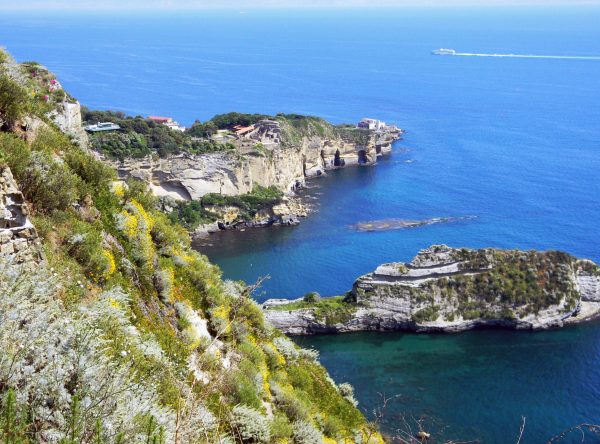 Pollio chose the tip of Cape Posillipo, along the slope of Marechiaro overlooking the Bay of Trentaremi.
Pollio chose the tip of Cape Posillipo, along the slope of Marechiaro overlooking the Bay of Trentaremi.
To his right he could see the island of Nisida, where Marcus Junius Brutus, the most famous of Julius Caesar’s assassins, had his Villa. It was here where Brutus and Cassius plotted the assassination. Further to the west was Baiae, where Julius Caesar and many successive Emperors built their summer estates.
Pollio called his Villa, Pausylipon, a Greek word that meant the ending of pains, a name that conjured up the splendor of Greek antiquity and the escape from the anxiety and stress of life in Rome, although Vedius Pollio could never really escape all of the anxiety of his life. He had very expensive tastes and in order to help pay for them, he set up income producing fisheries off the Villa’s jetties and piers over the Bay. The most cherished of these fisheries was his Eel pond.
Eel, with a sweet taste similar to shellfish, was an expensive and profitable delicacy of the Roman elite.
These days the Romans (and all Italians) still enjoy the taste of eel but the availability of the current eel variety (Anguilla Anguilla) is getting scarce.
The Capitone eel (Anguilla Anguilla), grilled, roasted, fried or stewed, still shows up on Christmas tables in many households throughout Italy.
Vedius Pollio and the Eel Pond
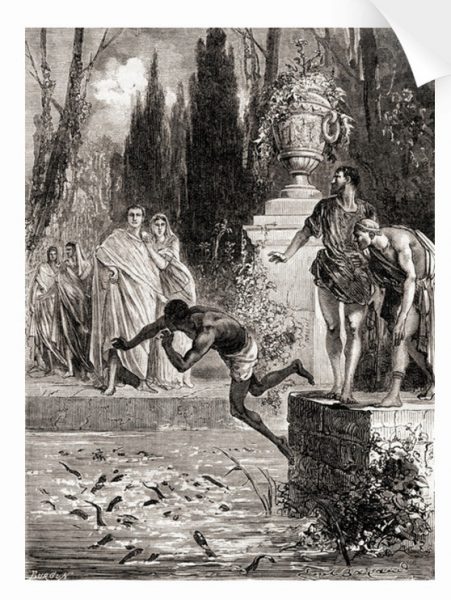 Pausylipon might have been the ending of pains for Vedius Pollio but definitely not for his slaves. Slave/servants who displeased Vedius Pollio were thrown into the eel pond. According to some accounts, Pollio would stand at the end of the pond and cheer and the eels tore apart the screaming servants.
Pausylipon might have been the ending of pains for Vedius Pollio but definitely not for his slaves. Slave/servants who displeased Vedius Pollio were thrown into the eel pond. According to some accounts, Pollio would stand at the end of the pond and cheer and the eels tore apart the screaming servants.
In researching this story I realized that there is some confusion as to whether Vedius Pollio had a pond filled with the razor sharp toothed moraena (moray) eels or the jawless, funnel mouth blood sucking lamprey. Both were popular in the diet of wealthy Romans.
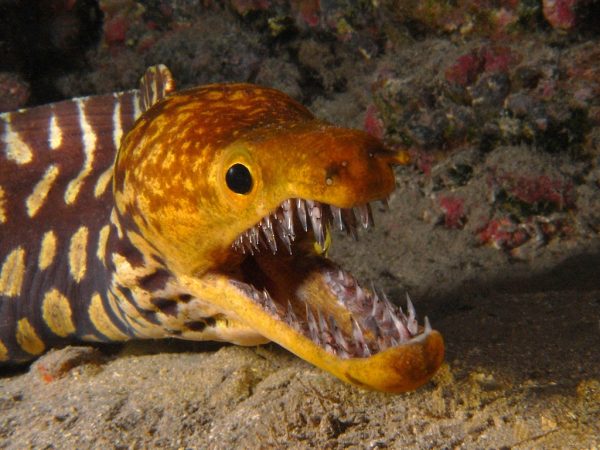 The muraena (moray) eel was larger and more spectacular. Pliny the Elder wrote the fish was actually named after Lucinus Murena who is credited with the first muraena eel farm, although Lucinus might have been called Murena because of his love of the eel. The eels were considered more valuable than the slaves who tended the ell ponds.
The muraena (moray) eel was larger and more spectacular. Pliny the Elder wrote the fish was actually named after Lucinus Murena who is credited with the first muraena eel farm, although Lucinus might have been called Murena because of his love of the eel. The eels were considered more valuable than the slaves who tended the ell ponds.
During the 1st century Roman elite made pets of their eels. Antonia the Younger, the daughter of Mark Anthony and mother of the Emperor Claudius fastened earrings to the dorsal fin of her pet eel.
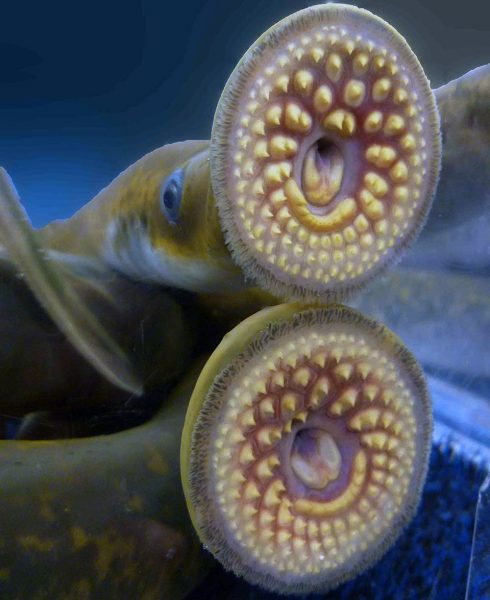 Lampetra (lamprey), also raised and consumed by the ancient Romans has been a favorite from King Henry I of England (who died from eating too many of them) to Queen Elisabeth II who has been gifted eel pies since her coronation in 1953.
Lampetra (lamprey), also raised and consumed by the ancient Romans has been a favorite from King Henry I of England (who died from eating too many of them) to Queen Elisabeth II who has been gifted eel pies since her coronation in 1953.
I’ve been told Lamprey meat tastes like squid. Eel pies (made with lamprey) have been an English tradition since the 19th century. You can still find Eel, Pie and mash (potato) shops in the UK.
The Roman historian, Seneca the Younger (4 BC – 65 AD) recalled the story of Vedius Pollio throwing his servants to the muraenae pool in his volume on anger, ‘De Ira’.
However, in his volume on mercy, ‘De Clementia’, Seneca states that Pollio would fatten his lampreys on the human blood of his slaves.
Seneca was born 11 years after Pollio’s death. His account of the story would be hearsay but possibly through someone who lived during the time of Vedius Pollio. His eel confusion might be through translation or his ignorance of eel species. By the way, lampreys are not eels, they are a very ancient and prehistoric vertebrate.
The historian, Cassius Dio (155-235 AD) wrote that Pollio kept lampreys in a pool that were trained to eat men. However, lampreys were capable of draining the blood from a human but moray eels would eat human flesh.
The historian and naturalist, Pliny the Elder (23-79 AD) in his volumes on Natural History recalls the story describing the slaves thrown to a pool of muraenae (moray eels). Pliny got the story second hand but he also had a much better knowledge of marine life.
Tertullian (155-240 AD) wrote that Pollio filled the bellies of toothless sea eels with his slaves. He also states that Pollio would cook the fish immediately after it had devoured a slave so he might taste the bodies of the servants he just put to death. Tertullian was an important Christian writer of the 3rd century who apparently had a wonderful imagination for creating a good story.
With all these versions of the story, I’ll surmise the eel pond was filled with large, gaping jaw, razor sharp saw toothed muraenae (moray) eels.
In the most famous story of Vedius Pollio, he invited the Emperor Augustus to a dinner party at Pausylipon and during the event a slave accidently broke a crystal goblet. Pollio’s anger sent the slave to the eel pond.
The slave pleaded for his life but Pollio was unmoved. The Emperor Augustus requested Pollio to spare the slave but Pollio wouldn’t listen, claiming the slave was his property and he could do whatever he wanted.
Augustus then ordered all the servants to bring to him all the crystal goblets in the villa. When they arrived Augustus broke every one of them and then said to Pollio if you can’t punish me, you can not punish the slave. The slave survived. In some versions of the story, Augustus purchased the slave and his family and brought them back to Rome.

When Pollio died in 15 BC, Augustus claimed all of his property. The Domus Pollio in Rome was destroyed and replaced in 7 BC with the Portico di Livia.
The grand enclosed colonnade dedicated to his wife lasted into the 6th century.
Augustus also claimed Pausylipon as his summer Villa. It is unclear how much of the Villa was built by Pollio and how much was added by Augustus.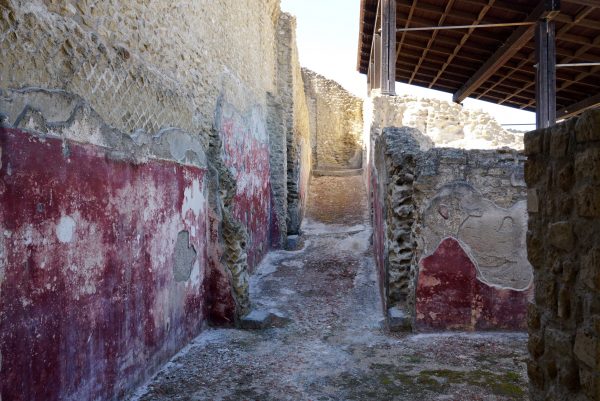
The complex was complemented with guest and servant quarters, nymphaea (summer houses), salaria (sun houses), triclinia (dining halls), wide embankments, piers, jetties and fisheries.
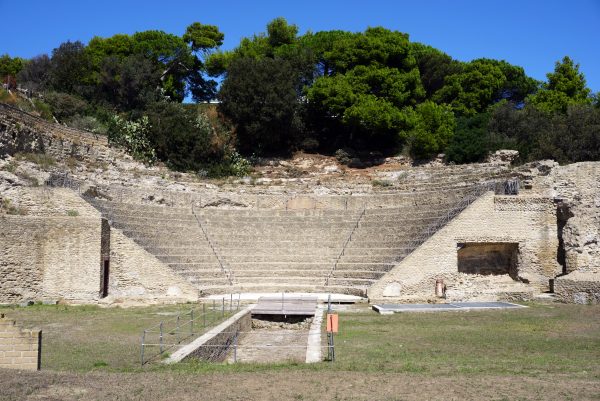 The large theater with a capacity for 2,000 people included a long aqua pool that was used for water dance performances.
The large theater with a capacity for 2,000 people included a long aqua pool that was used for water dance performances.
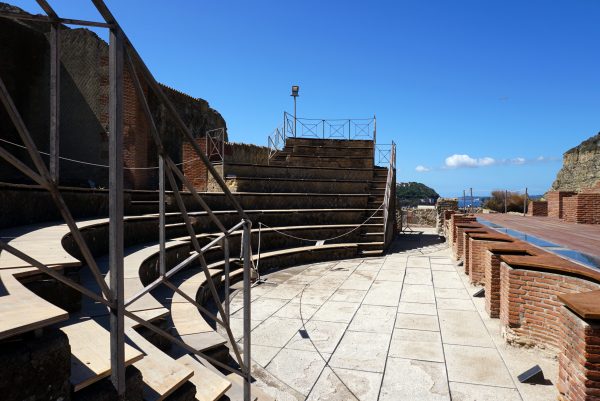 The smaller covered Odeon theater used for music recitals and poetry readings.
The smaller covered Odeon theater used for music recitals and poetry readings.
This was a place to entertain large groups of people. Not much is known about Vedius Pollio. If he was a man who threw events for 2,000 people, we would most likely know a lot more about him.
Pausylipon after Augustus
After the death of Augustus in 14 AD, the property was passed onto the Emperor Tiberius who probably stayed here until his massive Villa Jovis on Capri was finished in 27 AD. According to the 15th century, the humanist and poet, Giovanni Pontano, the grand tunnel that provides access to the Villa from the Port of Pozzuoli was constructed by the chief advisor to Tiberius, Lucius Aelius Sejanus.
As an imperial property, Pausylipon passed to every Emperor until Hadrian who died in 138AD. He was last to use the villa. In 138 AD, after the death of Hadrian, the Villa complex was cast aside.
Pausylipon was meant to be seen from the sea with the Greek style villa reflecting the water of the Bay of Trentaremi. The arrival to the tip of the Posillipo promontory was always by boat, but after centuries of earthquakes. tidal storms and erosion, the tip of Cape Posillipo collapsed, and with it went the Villa.
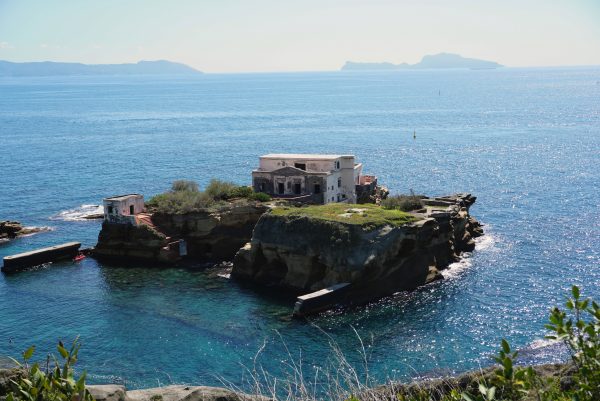 Most of the triclinia nymphaea, porticoes, loggias and mosaics fell off the mainland into the Bay. Some of these ruins can be seen in the submerged Underwater Archeological Park of Gaiola. The famous eel pond that once existed next to the villa is also gone. The promontory tip has been reduced to two small islets now known as the Isola della Gaiola.
Most of the triclinia nymphaea, porticoes, loggias and mosaics fell off the mainland into the Bay. Some of these ruins can be seen in the submerged Underwater Archeological Park of Gaiola. The famous eel pond that once existed next to the villa is also gone. The promontory tip has been reduced to two small islets now known as the Isola della Gaiola.
There are a few ways to see the underwater remains of the 1st century BC villa. You can go on a scuba or snorkel activity or an excursion in the Glass Bottom Boat called the Aquavision. Get more information at the park. https://www.areamarinaprotettagaiola.it/
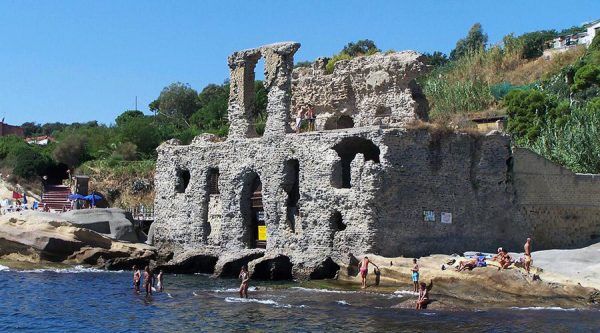 A small part of one of the Nymphaeum, known as the Palace of Spirits (Palazzo degli Spirit) is currently enjoyed by swimmers on the coast of the nearby fishing village of Marechiaro. You can see it from the Glass Bottom boat tour.
A small part of one of the Nymphaeum, known as the Palace of Spirits (Palazzo degli Spirit) is currently enjoyed by swimmers on the coast of the nearby fishing village of Marechiaro. You can see it from the Glass Bottom boat tour.
The Curse of Isola della Gaiola
However, if you do decide to visit the Underwater park, it might be a wise idea not to set foot of on the Isola della Gaiola. The island is (believed to be) cursed.
There is very little known about the villa after Hadrian but evidence of the curse goes back to the early 19th century.
In the early1800s a hermit known as il Mago, (the magician) lived on the Island. Not much is known about him. He kept to himself, accepting handouts from passing boats, and then one day he disappeared, vanished. Perhaps this is when the curse began. Maybe the place was cursed by one of the many slaves who were thrown into the eel pond. Whatever the origin, stories of the Gaiola Malediction have been around for a while. This list of unfortunate events is impressive.
The remains of the 19th century house on the island was built by Louis de Negri who’s fishing business ended up in financial failure in 1871.
In 1911, Capitan Gaspare Albenga was circling the island with intentions of buying it when his ship crashed into the rocks and sank. Some say the ship and Captain Albenga just disappeared.
Hans Braun of Switzerland, the owner of the island in the 1920’s, was found dead, wrapped in a carpet. His wife drowned in the Bay near the Villa a few months later.
In 1926, Elena Von Parish was swept to sea when the cable broke while she was riding the cable car that once connected the island to the mainland.
In the 1930’s, German Industrialist Otto Grunback, died in the villa from a heart attack and in the 1960’s, German Steel Magnate, Baron Karl Paul Langheim suffered financial ruin while living there.
When oil Baron, J. Paul Getty owned the property in 1973, his grandson, J. Paul Getty III was kidnapped by the Calabrian ‘Ndrangeta crime syndicate. After the kidnappers severed the boy’s ear and mailed it to the Getty’s, J.Paul agreed to pay $3 million in ransom for the then 16 year old boy. J. Paul Getty III never fully recovered from the incident and eventually died of a drug overdose in 2011.
In 2000, during the time the island was owned by Gianni Agnelli, the head of Fiat, his only son Eduardo committed suicide.
In 2009, Franco Gianpasquale Grappone, the island’s last owner, was indicted on charges of insurance fraud and sent to prison in 2009.
The Isola dell Gaiola is now owned and protected by the Commune of Campania. Unfortunate events in Campania continue but none of them have been (so far) related to the Gaiola Curse.
The Cave of Sejanus (Grotta di Sejanus)
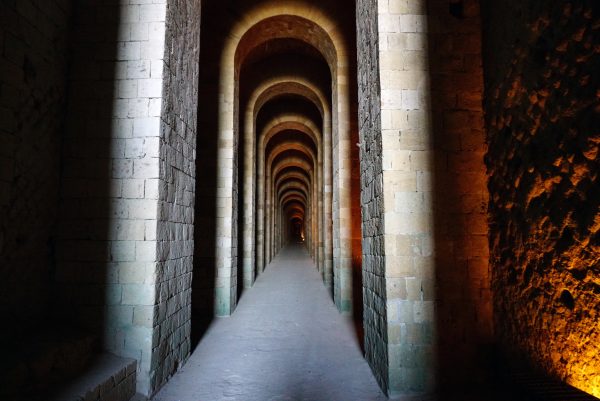 In the 15th century, the humanist and poet, Giovanni Pontano hypothesized that the 770 meter (2,541 foot) tunnel connecting the Coroglio side of the Posillipo Hill to the Imperial Villa Pausylipon had been built by Lucius Elio Sejanus, the chief advisor and head of the Praetorian Guard under the Emperor Tiberius .
In the 15th century, the humanist and poet, Giovanni Pontano hypothesized that the 770 meter (2,541 foot) tunnel connecting the Coroglio side of the Posillipo Hill to the Imperial Villa Pausylipon had been built by Lucius Elio Sejanus, the chief advisor and head of the Praetorian Guard under the Emperor Tiberius .
Sejanus was successful in becoming the most trusted advisor to Tiberius but his overconfidence became his downfall when he was set up to fall by Caligula, the heir to Tiberius. Sejanus was denounced, sentenced to death, strangled and tossed down the Gemonian Stairs. He was so hated by the people that as soon as his body hit the last step, crowds of Romans tore into the streets rounding up anyone they thought was associated with Sejanus and killed them. The killings of the family of Sejanus and his followers went on for quite a while.
During the Vedius Pollio years of Villa Pausylipon, the eastern side of the tunnel served as a fresh water cistern for the estate. Portano’s 15th century discovery was of ancient Roman origins but most likely not by Sejanus.
Most likely, the tunnel was constructed by Marcus Vipsanius Agrippa and Lucius Cocceius Auctus. Agrippa was the master builder, best friend and son-in-law to the Emperor Augustus. Cocceius was Agrippa’s architect.
In 38 BC Roman grain supplies were under attack by Sextus Pompey, the son of Pompey Magnus. The elder Pompey became the enemy of Julius Caesar during the civil war of 48 BC. Ten years later the son of Pompey and the adopted son of Caesar were at war.
The major grain supply was coming from Sicily and Africa and the fleet on the eastern side of Italy at Ravenna was too far to deal with the raids of Sextus and his pirates.
Augustus (Octavian at the time) gave the order to Marcus Agrippa to build a port for the western fleet. Agrippa together with Lucius Cocceius, they built a secret harbor undetectable by Sextus or his ships.
The Bay of Puteolis (modern day Pozzuoli) was a perfect cove to house a large fleet but too visible to the enemies of Rome. Agrippa decided to take two nearby freshwater lakes and connect them to the bay, literally creating a secret harbor. The port was named Portus Julius, after Julius Caesar.
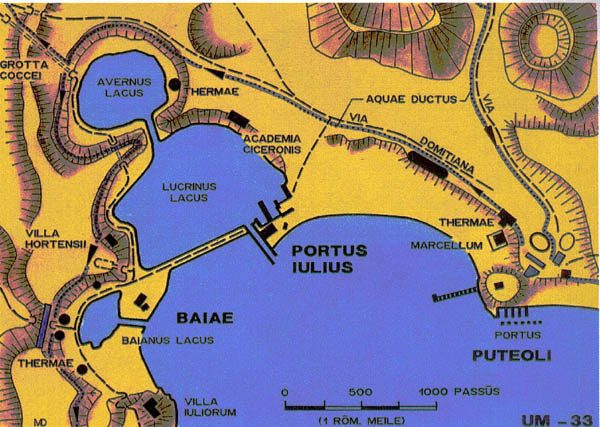 Lake Averno, believed by the Romans to be the entrance to the underworld of Hades, would be the location of the fleet. Agrippa and Cocceius built a canal from the Bay to Lake Lucrino and then another canal from Lake Lucrino to Lake Averno.
Lake Averno, believed by the Romans to be the entrance to the underworld of Hades, would be the location of the fleet. Agrippa and Cocceius built a canal from the Bay to Lake Lucrino and then another canal from Lake Lucrino to Lake Averno.
The materials and personnel for the fleet would be supplied by land through two tunnels. The Crypta Neapolitana, would bring supplies and military from Neapolis (Naples). The Crypta Cocceio would bring supplies and military from Cumae, home of the Cumaean Sibyl immortalized by Michelangelo on the ceiling of the Sistine Chapel.
When Portus Julius was finished there were warehouses, maritime schools, Temples, prostitutes, restaurants and bars.
In 36 BC, Agrippa took the fleet from the Port to Sicily and destroyed Sextus’ fleet at the Battle of Naulochus.
Portus Julius remained a working port till around 12 BC when the lakes began to silt up and clog the canals. After the war with Sextus Pompey, the hidden harbor wasn’t really needed anymore and with the upkeep so laborious, the Port eventually moved to to Miseunum, current day Bacioli and Miseno. After that earthquakes and shifting tides pulled Portus Julius into the Bay. Many of the pieces from the ancient Port can still be seen on scuba dives. There are a number of good dive companies offering tours of the Underwater Archeological Park of Baiae.
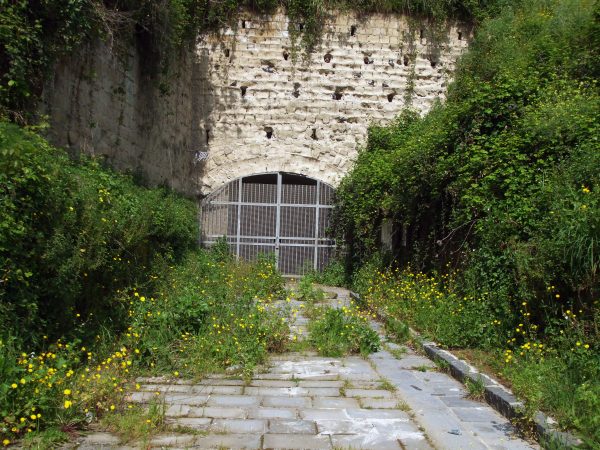 In the 16th century, the Crypta Cocceio was also known to as the Grotta della Pace for the Spanish Captain, Pietro de Pace, who plundered the ancient ruins of Cumae between 1508-09 and stored them in the tunnel.
In the 16th century, the Crypta Cocceio was also known to as the Grotta della Pace for the Spanish Captain, Pietro de Pace, who plundered the ancient ruins of Cumae between 1508-09 and stored them in the tunnel.
After heavy damage during World War II, the Grotta was closed to the public. It remains closed.
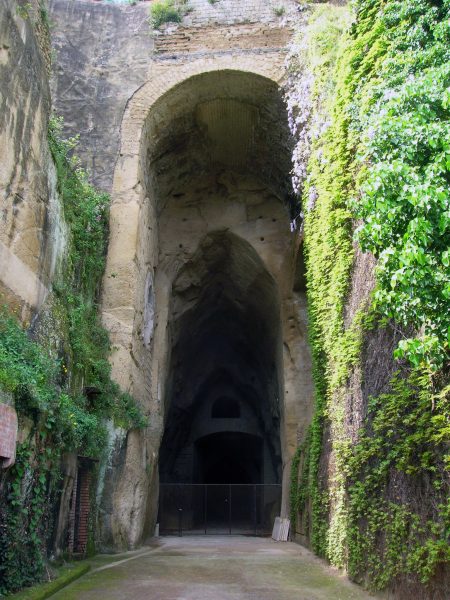 The Crypta Neapolitana, was a much more ambitious project tunnel connected the Neapolis harbor near the Castel dell’Ovo to Lake Averno.
The Crypta Neapolitana, was a much more ambitious project tunnel connected the Neapolis harbor near the Castel dell’Ovo to Lake Averno.
It was construction at 4.5 meters wide (close to 15 feet) in order to accommodate two Roman carts filled with supplies.
According to some legends, Cocceio used 100,000 men to dig the 711 meter long tunnel in just 15 days.
The tunnel goes through two districts of Naples; the eastern Piedigrotta, in the Chiaia district of the historic center of Naples, and the Fuorigrotta in the suburban west of the city near the Stadio San Paolo, the home of the S.S.C. Napoli football team.
The Crypta Neapolitana was widened in 1445 by King Alfonso the Magnanimous. There is still a plaque dedicating the work to the 15th century King at the entrance to the ancient tunnel. Since 1455, it was repaired again in the 1540’s, again in 1748 and once again in 1893 by the Municipality of Naples.
In the 1930s, the eastern Piedigrotta entrance, was rebuilt as the Vergiliano Park, It includes a columbarium which supposedly contains the tombs of the ancient Roman poet Virgil and the 19th century poet/philosopher, Giacomo Leopardi.
You can visit the eastern side and the western side but not the entire tunnel. The center section has experience too many collapses and has been closed.
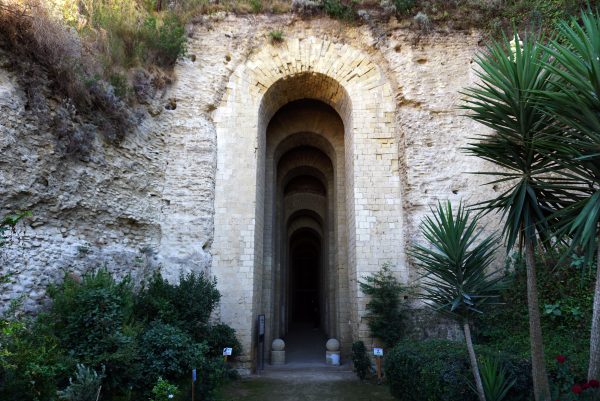
The Sejanus tunnel is complete from one end to the other. Even though it was possibly erroneously named by Giovanni Pontano in the 15th century, the discovery was enough to get him the funds to rebuild it.
Most likely the Crypta Sejanus was also built by Marcus Agrippa and Lucius Cocceio in 15 AD after Augustus took possession of the property. The tunnel gave Augustus easy access to the Portus Julius.
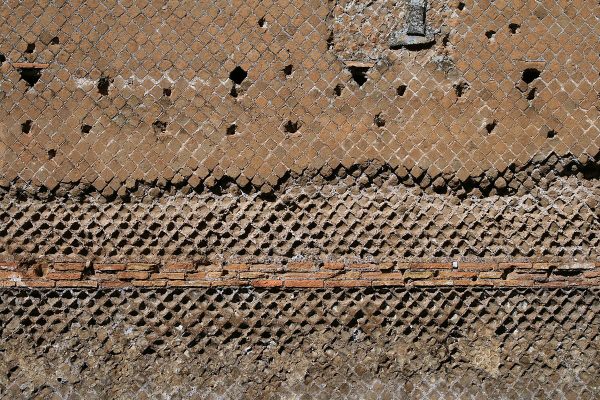
The eastern side of the tunnel, approximately 144 meters of pozzolanic and tufa stone was lined with masonry in opus incertum and opus reticulatum, construction methods used in the 1st century.
The vault was lined with concrete (opus cementicium).
The western side of the tunnel was mostly tufa stone. The restoration was extremely difficult. From the absence of light, the poisonous gas and the hard work of digging out the stone, laborers could only dig 5-7 meters a day, less than 23’. You can still see the ‘casting restarts’ where the holes supporting the beams used to cast the vault were moved every day. When you’re inside the tunnel you can only imagine how many people died digging it for Agrippa and Cocceio.
There are necessary air shafts every so often to compensate for the poisonous gas produced by the stone. I’m sure the air shafts were not there when the tunnel was first dug out.
Over the years the lack of use and neglect caused major damage to the 15th century restoration. Much of it had caved in on itself. One of the lateral ducts was rediscovered in 1826 during the construction of the Correggio Ramps on the Pozzuoli Harbor side of the hill.
In 1840, King Ferdinand II (King of Two Sicilies) gave the commission to Ambroglio Mendia to rebuild the tunnel. It was finished in 1841. Mendia, reported 10 collapsed sections but they were able to rebuilt all 770 meters of the tunnel.
During World War II, the tunnel was used as a bomb shelter for the nearby residents of the industrial city of Bagnoli. You can still see small latrines and seats carved into the tufa stone from the war years.
The landslides continued until the tunnel was reconditioned again in the 1950s. These days the tunnel gets regular maintenance.
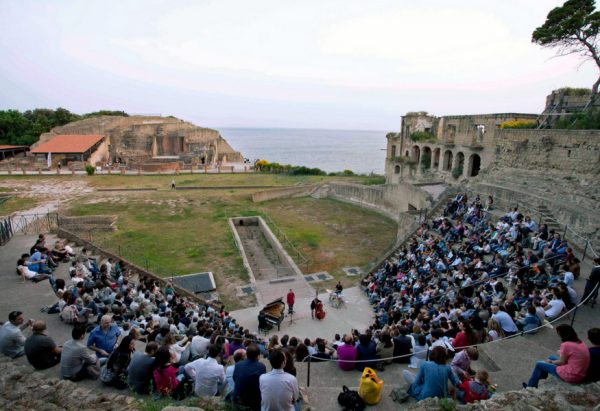 The Villa is open to the public year round. In May and June music events are staged at the large theatre for the Imbrunire Festival. https://www.suggestioniallimbrunire.org/
The Villa is open to the public year round. In May and June music events are staged at the large theatre for the Imbrunire Festival. https://www.suggestioniallimbrunire.org/
Arriving to Pausylipon is not too difficult. The easiest way is by car or cab from Naples. The cab fare is between €18 and €26 each way and takes about 20-25 minutes. Make sure the cab driver takes you to the Dicessa Coroglio entrance. This is the entrance to walk through the Grotta di Sejanus. The Dicessa Gaiola is the entrance to the Underwater marine Park. Ask the guide at the Villa Pausylipon to call a cab to take you back.
If you want to take the bus, the F9 bus stops at the entrance to Grotta di Sejano.
The tours to the Villa are given in Italian, French and English. The cost is a mere €5. You need to make a reservation by calling +39 081 2403235 for the Underwater Park reservation or +39 328 5947790 for the Grotta Sejano and the Pausylipon Park.
Grotta Sejano and Villa tours
Tuesday through Friday – tours are at 12:00 pm
Saturday tours are at 10:00 am and 12:00 pm
Sunday tours are at 10:00 am, 11:00 am and 12:00 pm
You can also send an email request to: info@gaiola.org
http://www.gaiola.org/Pausilypon.htm
The Villa, Grotta and Underwater tour on the glass bottom boat is a 3 hour adventure for €20. These tours are at 9:00 am.
You must be logged in to post a comment.